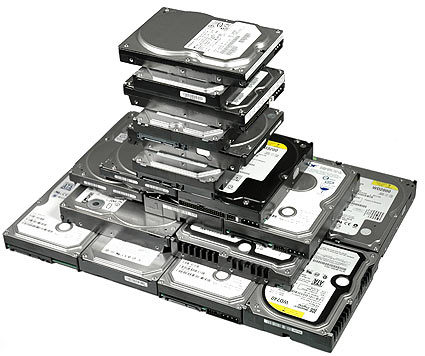Round-Up: Comparison Testing of 22 Hard Disk Drives
Summary And Conclusions: Current Drives Are Fast Drives
Our complete set of test results let us get a reasonably comprehensive overview of average disk drive performance over the past few years, and also brings information about numerous current models together. Unfortunately, we couldn't compile an exhaustive collection of all market offerings, so we must also promise to follow up with coverage of certain Samsung drives, and the Western Digital WD4000.
Nevertheless, the results we did compile allow us to come to some definite and independent conclusions. Increases in work-handling capabilities and outright capacity aren't as dramatic today as in years gone by, when it was more typical to see steady increases of 100% (say, from 100 GB to 200 GB, for example.) And while performance differences from one drive generation to the next may be measurable, only in a few isolated cases do increases make a perceptible difference to users. Features like command queuing are technically impressive but don't have a big impact.
Thus, to our way of thinking, the main argument for upgrading any drive that's less than three years old is a crying need for more space. As you can see in the test results, the biggest hard disks (as determined by storage capacity per platter) are also the fastest. That's why we see space as the primary impetus for upgrades.
The Western Digital Raptor drives provide outstanding exceptions to this rule. Despite being introduced nearly two years ago, they continue to trump all 7,200 RPM counterparts in performance, and by a pretty wide margin at that. In concert with the trend in the IT market sector to provide exclusive products to important customers, there's no current premium drive that gives the Raptor a run for the money.
That said, a 10,000 RPM drive that incorporated current data densities and drive technologies could raise the performance bar noticeably, without having to restrict storage to a relatively small size, as is true for 36 and 74 GB Raptors right now. We'll just have to see if somebody's willing to rise to this challenge.
To those who might wish to upgrade an existing UltraATA system, we currently recommend the Hitachi Desktop T7K250 because of its great price/performance ratio. Those seeking bigger drives should consider offerings in the WD3200 family or the Barracuda 7200.8 lines: neither suffers from excessive access times, and both offer plenty of capacity. We'd build new systems around the Western Digital 3200JD right now, but if faster performance is absolutely essential, the 74 GB Raptor remains today's device of choice - just as it was yesterday's.
Get Tom's Hardware's best news and in-depth reviews, straight to your inbox.
Current page: Summary And Conclusions: Current Drives Are Fast Drives
Prev Page PCMark HD Benchmarks
Patrick Schmid was the editor-in-chief for Tom's Hardware from 2005 to 2006. He wrote numerous articles on a wide range of hardware topics, including storage, CPUs, and system builds.
